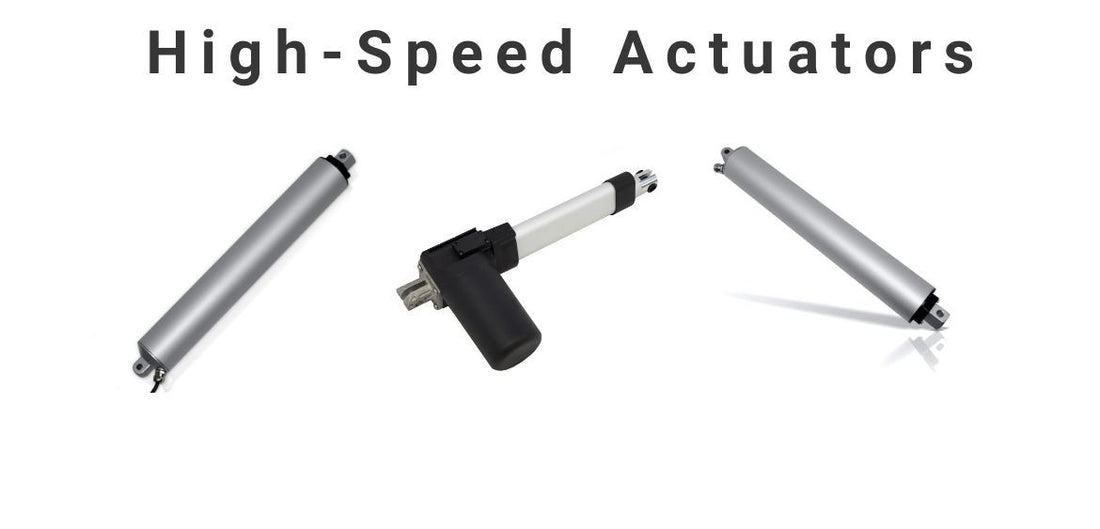In recent years, the use of linear actuators in industrial and non-industrial applications has proven to be indispensable. Choosing the right linear actuator for an application can be quite confusing due to the vast array of types and parameters that need to be considered (i.e. stroke length, motor type, force, and speed). High-speed linear actuators have become quite popular, but what are the differences between opting for a fast linear actuator versus a standard linear actuator? And what applications are more suited to a high-speed actuator? Answering these questions will involve taking a deeper dive into some subtle, and not so subtle, differences in componentry and characteristics. To help you with your search for high-speed actuators, we give you two of the best options from Progressive Automation’s catalog.
Characteristics of High-Speed Linear Actuators
High-speed linear actuators are known for being durable/robust and run quieter due to less moving parts. They are easy to integrate into existing control systems and usually run on lower voltages (i.e. no need for industrial 3-phase voltage). However, an important parameter to keep in mind is the linear actuator’s duty cycle. Brushed DC motors cause friction and can result in the motor heating up if run for prolonged periods.
Standard linear actuators make use of a servo motor. Servo motors consist of a DC motor connected to a geared drive and sometimes a potentiometer, allowing for feedback control. What this means is that combined with a controller, the forward and backward stroke of the linear actuator can be accurately positioned. Conversely, high-speed linear actuators are designed to run the full backward and forward motion without intermediary position control.

How Are They Classed as High-Speed Linear Actuators?
Since speed is relative, how can one determine whether a linear actuator should be classed as ‘high-speed’? No industry standards are currently available for high-speed linear actuators or ultra-high-speed linear actuators, which outline minimum specifications, so it is up to the manufacturer to decide how the actuator should be classed. These classifications would be based predominantly on the following:
- Speed of back and forth actuation.
- Load/no-load force.
- The drive mechanism.
- The actuator type.
- Gearing.
It is important to understand these parameters to make an informed buying decision on a high-speed, high-force linear actuator. Using the Compare function on the Progressive Automations site, you can compare up to four actuators at once with the above parameters in mind when making your decision.

How Can I Change the Speed of My Linear Actuator?
As listed above, speed is dependent on the drive mechanism. Many high-speed linear actuators use a brushed DC motor directly connected, in line, with a lead screw, which is connected to a shaft/piston. When power is applied to the motor, it rotates the lead screw and forces the shaft to move out (i.e. electrical energy converted to rotational motion converted to linear motion) and when the polarity of the power is reversed, the shaft moves back in.
Limit switches are located at the extremes of the shaft movement, thereby, cutting power to the motor when the shaft has extended/retracted fully. The speed of linear actuation can be changed by adjusting one or a combination of parameters, including:
Changing the Pitch of the Lead Screw
Simply, a larger pitch would increase the speed of linear actuation and vice versa.
Varying the applied voltage
If a motor’s shaft rotates at full speed at its rated voltage, then the speed of rotation can be decreased by simply applying a lower voltage. Often, a high-speed 12-volt linear actuator with potentiometer controls can be used (i.e. a motor controller). Basic controllers use an H-bridge circuit to reverse the motors polarity and a potentiometer to vary the voltage applied to the motor.
Gearing the motor
Some high-speed linear actuators, such as Progressive Automation’s PA-04 model (discussed later), use a geared approach to either slowdown or speed up a motor’s output rotation. Gearing also increases the force of the moving shaft/piston using the same strength motor.

High-Speed Linear Actuator Applications
When it comes to deciding on a high-speed linear actuator, it is crucial to know what application you are going to use the actuator for. Higher actuation speeds mean a lower output force and vice versa. However, gearing that same linear actuator could provide you with just the right amount of force to make it applicable to your needs.
The applications for high-speed linear actuators are endless. They provide excellent mobility for applications that require a smooth linear motion. Moreover, they are generally lighter than standard linear actuators since they do not contain a large gearbox. The lighter, user-friendly design allows them to be used in applications that require space to be saved or to reduce a system’s device footprint. The duty cycle is a percentage of the total time a motor is divided by the off-time. Sticking below this percentage will prevent motor overheating. Therefore, high-speed linear actuators are designed for applications that can operate within the specified duty cycle (usually 20%). Applications that suit this duty cycle include:
- Intermittent sorting automation.
- Home/furniture automation (although linear actuator feedback would be required to ensure accurate positioning).
- Robotic arm end-effectors.
- Non-industrial uses such as in-flight/driving simulations requiring high-speed actuation for realistic experiences.
The above applications are just a few examples of where high-speed linear actuators could be used.
Progressive Automation’s High-Speed Linear Actuators
Progressive Automation offers two high-speed linear actuators (PA-15 and PA-04 models), which are highly customizable to suit your application.
PA-15

The PA-15 high-speed linear actuator has a 12 VDC (2A no-load and 9A full load), direct-drive, brushed DC motor located in line with a lead screw allowing for a space-saving, highly robust model. Stroke lengths of 1-inch to 24-inches are available. Moreover, 3 options are available depending on the required force (i.e. 11lbs, 22lbs, or 33lbs). The no-load speed of this linear actuator is 9.05-inches/sec for the 11lbs option, 5.50-inches/sec for the 22lbs option, and 3.20-inches/sec for the 33lbs option.
However, when selecting a high-speed linear actuator, the full load speed should be kept in mind. At the full load of 11lbs, the speed is 4.70-inches/sec, 22lbs the speed is 4.00-inches/sec and 33lbs the speed is 2.00-inches/sec. Unfortunately, this model does not have any feedback circuitry, but limit switches are located at the extremes of the movement. The duty cycle is at 20% and the product is IP54 protected, meaning that it is protected against dust, harmful deposits, and limited water ingress. The product also comes with a standard 18-month warranty.
PA-04

The PA-04 linear actuator is technically not high-speed, but the force that it is capable of is fast compared to other models. The PA-04 model uses a 12 VDC (4A no-load and 12A full load) brushed DC motor that is positioned perpendicular to the lead screw. The motor is geared to allow for an increased force of up 100lbs at a linear speed of 2.16-inches/sec and 400lbs at a linear speed of 0.78-inches/sec. Stroke lengths of 2-inches to 40-inches are available.
This model does have optional feedback capabilities and has the option of using hall effect sensors instead of mechanical limit switches at the extremes of the actuator’s movement. The duty cycle is also at 20% and the product is IP66 protected, meaning that it is totally protected from dust and water ingress and is Progressive Automations best light-duty, high-speed, and waterproof linear actuator.
Conclusion
High-speed linear actuators can be used in a variety of applications, both industrial (high-speed, heavy-duty linear actuator) and non-industrial (miniature high-speed actuator), due to their robust design and fast actuation capabilities. However, when choosing a high-speed linear actuator, one should consider the discussed parameters to weigh the speed of actuation with the full load force, to ensure the linear actuator can handle the task at hand. Lastly, only purchase high-speed linear actuators from brands that provide an added warranty, which is a good sign that the manufacturers are confident in their product offerings.




